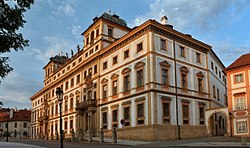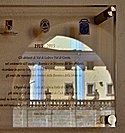Portrait of Empress Eleonora Gonzaga (1598–1655)
| Caption from the auctioneers website |
|---|
|
Eleonora Gonzaga, the youngest daughter of Duke Vincenzo Gonzaga I of Mantua and his wife Eleonore de' Medici, was born in 1598. In 1622, she married Ferdinand II of the House of Habsburg, who had been crowned Holy Roman Emperor just three years previously. Despite the fact that Ferdinand's marriage to his previous wife, the deceased Maria Anna of Bavaria, had produced seven children, his marriage to Eleonora Gonzaga remained barren. Eleonora passed away in 1655 and was buried in the Carmelite Abbey in Vienna before being transferred to St. Stephan's Cathedral in 1782. This imposing three-quarter length portrait depicts Eleonore Gonzaga in an intricate courtly gown of pale brocade trimmed with Venetian lace and with opulent jewellery. The empress wears a medallion with her husband's initials “F II.” pinned to the red sash around her waist, and the Austrian Imperial crown rests on the table beside her. The drapery in the upper right provides a further symbol of her majesty whilst simultaneously forming a compositional counterpart to the red of the tablecloth. The predecessor to this portrait was carried out by Sustermans himself in 1621 and is today housed in the Kunsthistorisches Museum in Vienna. In this work, a small dog takes the place of the Imperial crown, as the work was painted before Eleonora and Ferdinand were married. |
Relevantní obrázky
Relevantní články
Eleonora Gonzagová (1598–1655)Eleonora Gonzagová, nazývaná také Eleonora Toskánská byla mantovská princezna a jako manželka císaře římskoněmeckého a krále českého Ferdinanda II. také královna česká a císařovna římská. .. pokračovat ve čtení
Italové v ČeskuItalové, ve starší češtině nazývaní také Vlaši, se v českých zemích v průběhu staletí vyskytovali v různém množství a intenzitě, nelze však hovořit přímo o migraci. Ve starší češtině se lze setkat s označením pro Italy Vlaši, například „Vlašský dvůr“ v Kutné Hoře a dalších označení jako vlašský salát, vlašský ořech. Etymologicky se jedná o společný základ příbuzný s výrazem Włochy (pomn.) – Itálie, užívaný v moderní polštině. .. pokračovat ve čtení











